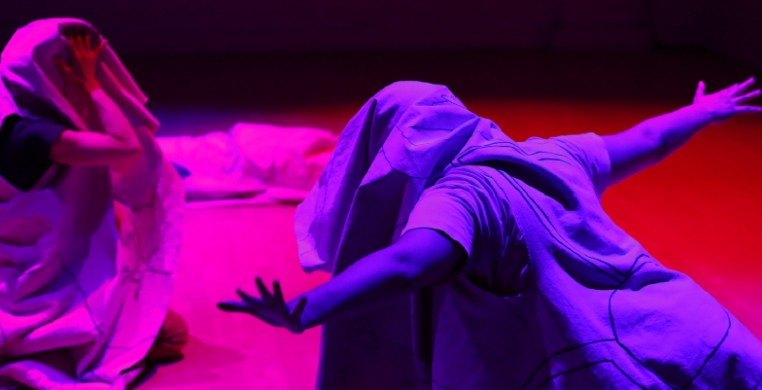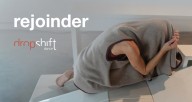A sense of spatial abstractions hit me as soon as I entered the theater to take in “rejoinder,” the latest work presented by dropshift dance, a collaborative cohort of contemporary artists, founded in 2010 by Andrea Cerniglia. The company focuses on creating abstract artistic works through collaborative processes. True to mission, both works on the program claim no choreographer, only collaborators.
My attention is drawn immediately to the dance floor. For the audience, chairs are arranged in a staggered semicircle configuration. As a seating alternative, there are also three floor mats spread out equidistantly, atop which lay pillows colored ash, brown and burnt orange. Centerstage are two stools, one a tall, skinny nightstand, the other a short, stubby, footstool. They are surrounded by three blankets with unique designs — one has fenceposts floating high above patches of green and brown farmland, another shows disembodied arms waving above red and purple flower petals, the last is a black and white checkerboard with two blue herons standing on either side.
The program begins with “DWELL/burrow,” a work directed by Cerniglia featuring her and dancers Christina Chammas and Alexandra Claiborne-Naranjo. Under a pulsing blue circle of light, three figures wearing different t-shirts and the same brown slacks in turn sit atop one of the two stools. The sound of violins being dragged against aluminum siding incentivizes one of the dancers to grasp tentatively at the air as if searching for something in the dark with her fingertips. Bird-like cheeps motivate another dancer to stretch their arms overhead, as if to signal “I’m awake.” The third, balancing on her stomach atop the nightstand, hyperextends her neck, arms, and legs backward like a plummeting skydiver. Their movements range from mundane to imaginative. Worlds collide as the three superimpose themselves against one another, like memories of the same person being thought about at different times.
The three elaborately designed blankets are used to great effect as they are donned by the dancers and turned into the drooping skin of three abominable nightmare creatures. To pizzicato plucked strings the beasts emerge, with one lunging at the audience and loudly flapping their wings, a clear territorial warning. Like a fat beetle, one crawls slowly up and over the stools. On their hind legs, one mimics a shrouded beggar, extending their hand towards an audience member — don’t trust it! Oddly, the part that induces in me the most terror is when they do not move at all, posing perfectly still, just…watching.
In a transitionary moment, grainy recordings of people reminiscing about loved ones are juxtaposed over what sounds like cellos being sawed in half—the work of sound designer Scott Rubin—the lights shift from white, to blood red, to blacklight — the work of lighting designer Richard Norwood. Meanwhile, the dancers perform purposeful in-and-out of sync do-si-do spins, arms slicing through the air. The work ends with a retrograde of the movements from the beginning of the piece, bringing the work full circle. “DWELL/burrow” is an abstraction of the humdrummery, anxiousness and terror that we all feel in everyday life.
“Ghost Ensemble” is a collaboration with guest artist Anna Kasdorf and The Space Movement Project, an all-female contemporary dance collective. Collaboratively composed but performed solo by Kasdorf, “Ghost Ensemble” resembles a series of still, three-dimensional pictures, the subject slowly morphing from one to the other, like a “before and after” sliding effect used when showing pictures of people aging on television. In a simple white dress and peach shorts, Kasdorf, noticing something in the distance, goes through a series of slight facial alterations — inquisitive, prying, mild hostility, contemplativeness and, finally, a dreadful nonchalance. It’s that last one that sticks with her through the rest of the piece, a permanent stoneface. She molds herself into asymmetrical statues, knees bent, one foot arched up, head tilted to the side, one arm angled overhead, fingers spread wide. There are moments of looseness, Kasdorf drunkenly lurches forward, balance shaky, set to the sound of a robot scratching out sonic poetry on a chalkboard. Performed at a burningly slow pace, there are times when my mind did begin to wander, but then I was always brought back by a slight movement—or the perception of movement— I may have seen out of the corner of my eye. The thought I kept coming back to throughout the performance related specifically to what she could have possibly seen at the beginning of the piece that affected her so. But perhaps I don’t even want to know.
I found myself constantly reflecting inward based on relatable moments onstage. To the casual observer of dance, the work might appear too leisurely, but each piece is best appreciated as one would a painting, not meant to be viewed and put away, but to be considered and dwelled upon. There was no hand holding. Works such as these require the audience to engage themselves, to actively imagine along with the dancers. In this age of “too long, didn’t read,” “rejoinder” forces you to put your thinking cap on, sit still for an hour, and consider the big picture.




